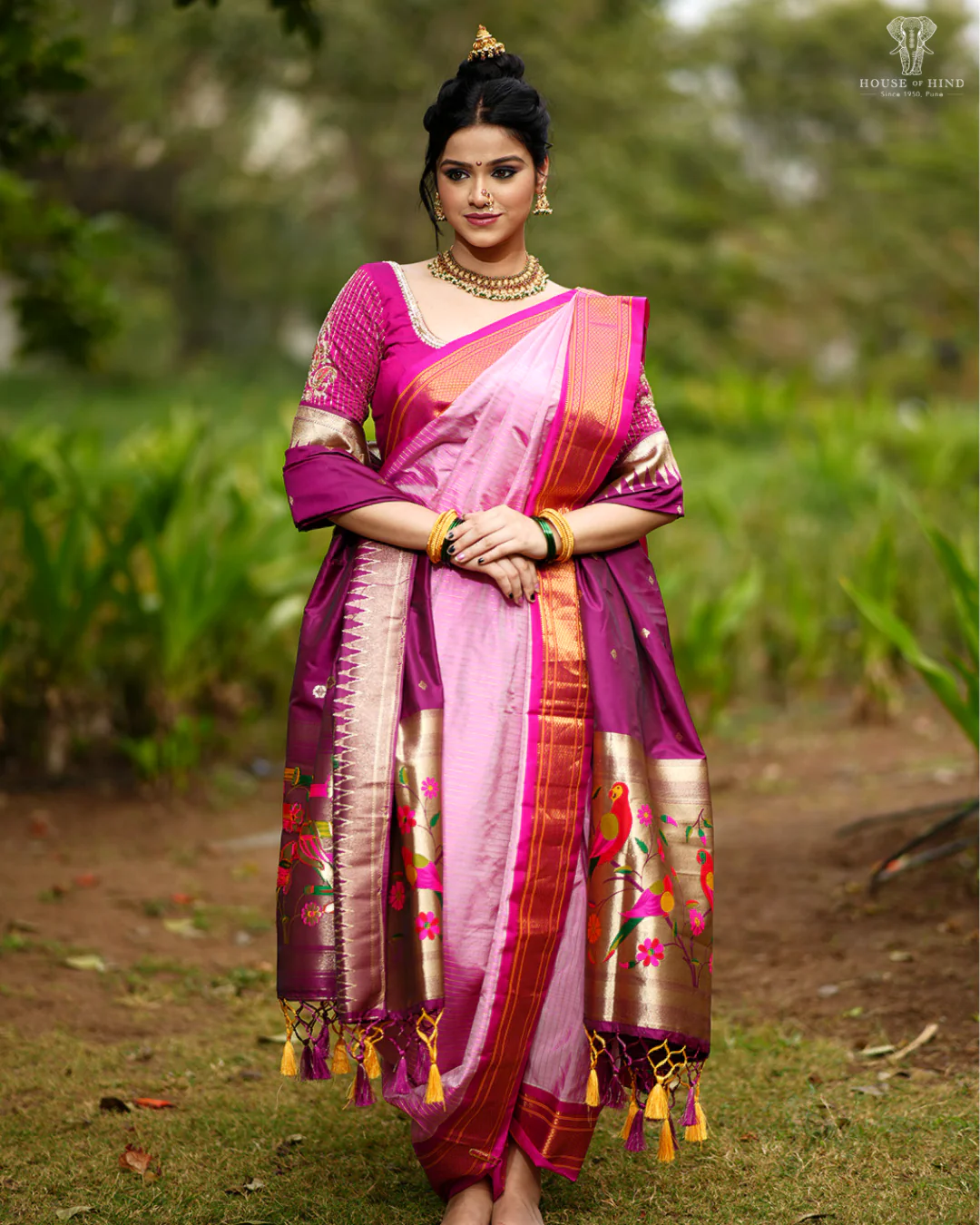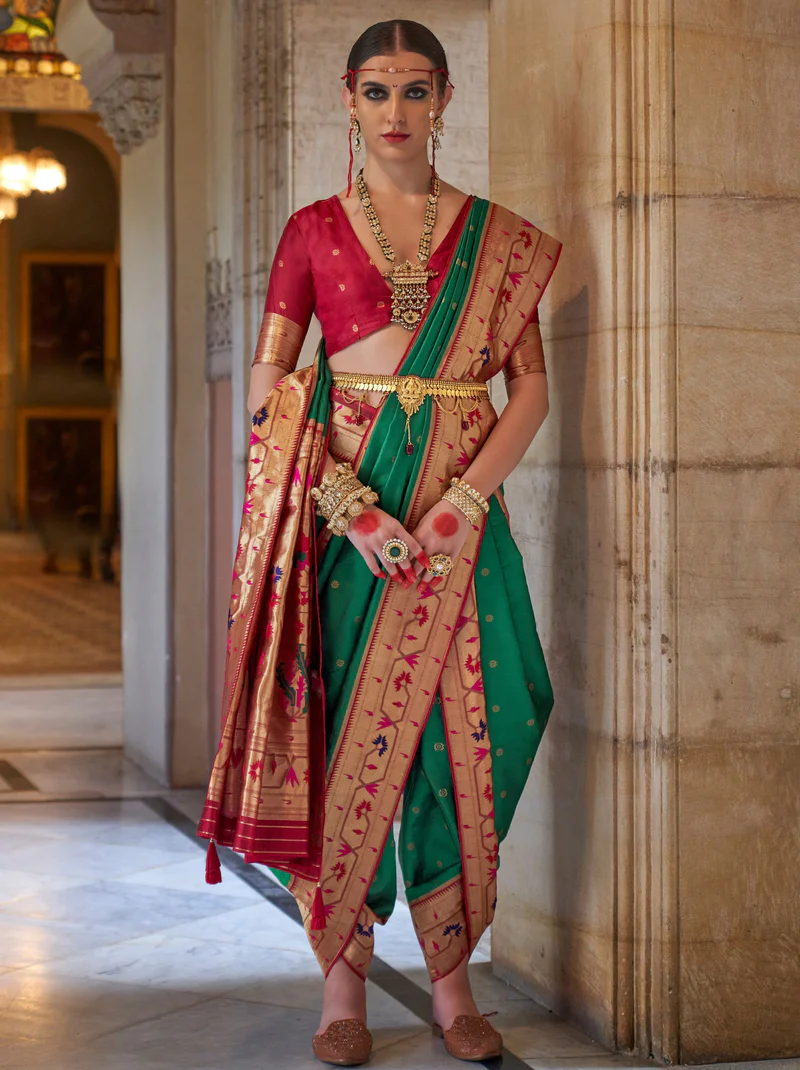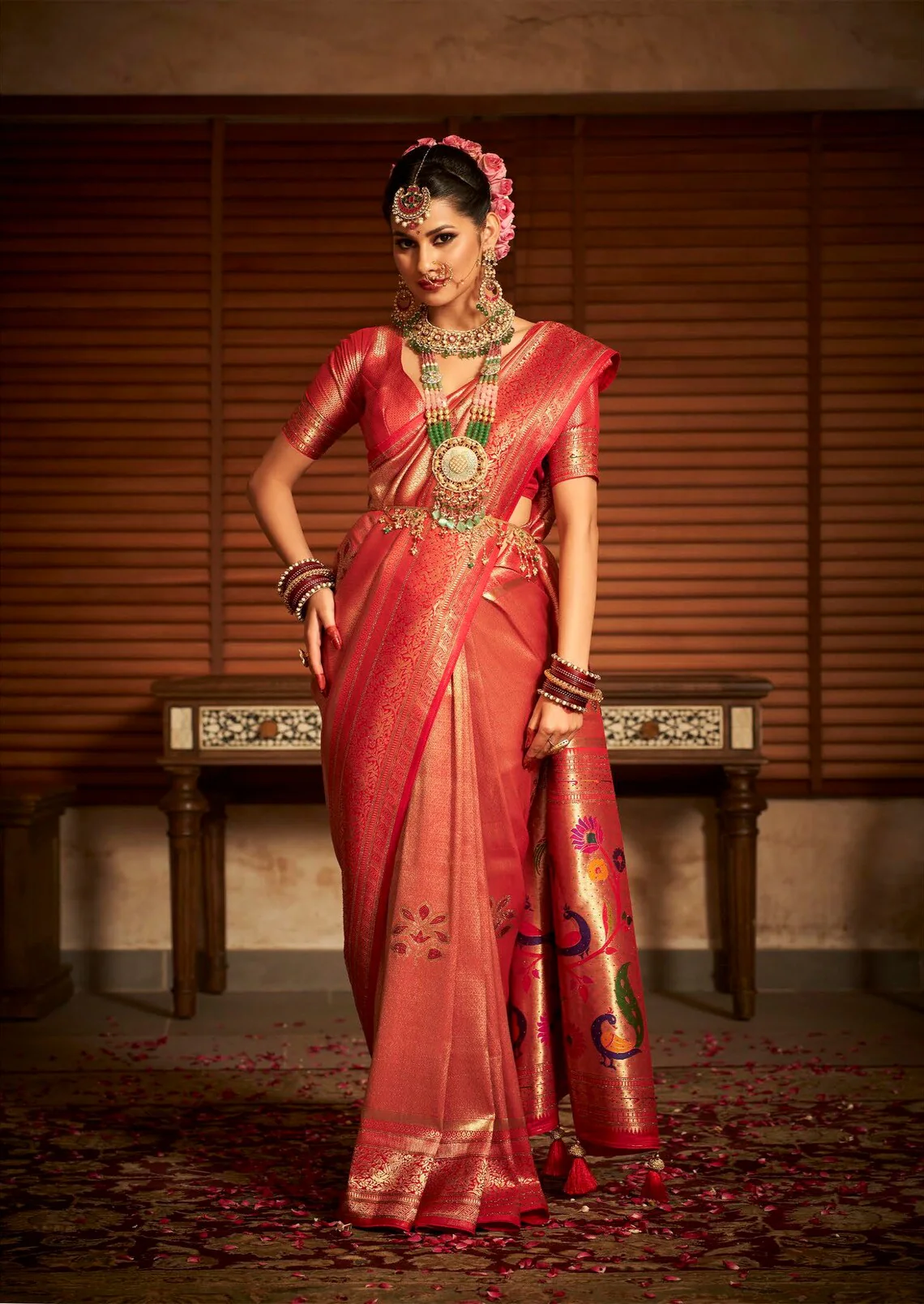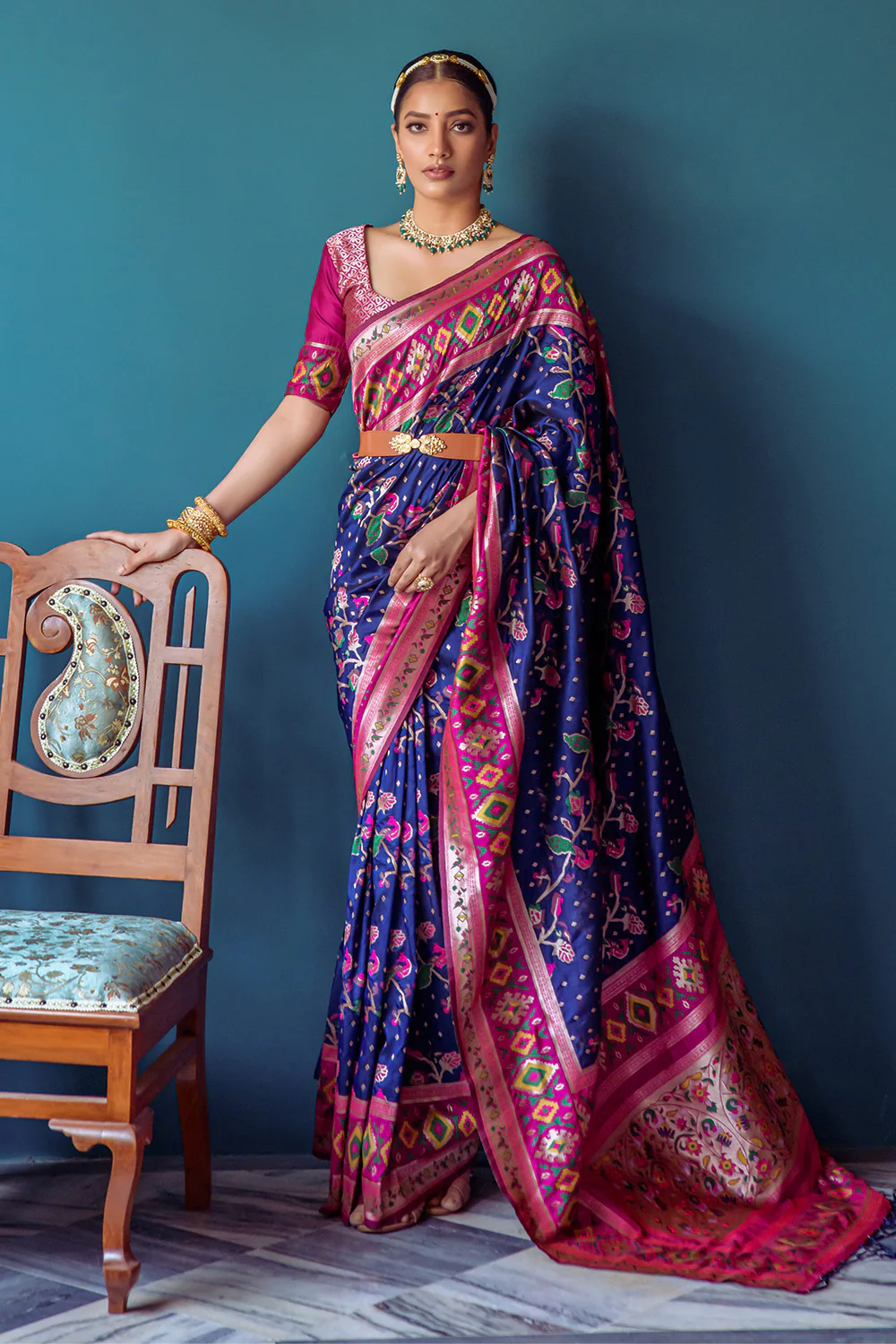Yeola Paithani Silk Saree for wedding
- Trusha Kenil
- Apr 9
- 6 min read
Updated: May 9
Introduction

Paithani sarees are hand-made with likely the best silk materials. These sarees start from Yeola-a fair neighborhood Maharashtra. They are portrayed by a breaking point zari pallu and line, nearby complex bowing around approaches and standard Paithani centers. The key body of the saree is twisted by hand in looms, while the bowing around outline of the pallu and line is evidently the injury around masterpiece turning structure. Likewise, Paithani sarees are for the most part turned with subjects of creatures, birds, and divinities.
Paithani sarees are from time to time improved with magnificent themes fortified essentially, like peacocks and blossoms. It regularly has an impressive breaking point bound with plans of birds and sprouts.
The Yeola Paithani silk saree for wedding absorbs the spirit of Maharashtra's wealthy records and good lifestyle inside each weave. Silk and Gold: The Paithani is handwoven using traditional silk and gold strings. It is seen for its over the top material and muddled plans.
History of Paithani Silk Saree
Saree has been a basic piece of Indian dressing for quite a while. Indians love conventional handlooms, which weavers have shielded for a really long time. Notwithstanding, when the handloom business of India was in grave peril, the nearby Indians and the illustrious family assisted with saving the craftsmanship for a truly extended stretch of time.
Paithani sarees have seen the obvious viewpoint on different brilliant lines routinely through middle age India. They are the beginning of relics condemned by the extraordinary exhibition of Paithan close to Aurangabad in Maharashtra.
The Mughals, Nizams, and Marathas all revered and supported the Paithani tradition, which producers had preserved for two millennia. A new range known as the Yeola Paithani was created in the middle of the seventeenth century when the Peshwas moved their extended manufacture from Paithan to Yeola.
The introduction of technologically advanced looms when the British Raj caused a setback for the Paithani business, but with federal funding and enthusiasts of the skill, the sector has seen a resurgence in recent years.
How is Yeola Paithani Saree Made?

It takes precise hand, foot, and eye coordination to weave a Yeola Saree on a standard handloom.
Using natural dyes derived from veggies, plants, stones and substances, basic silk strands are first dyed. After that, the loom is loaded with these threads. One of the hardest tasks is getting the loom ready, which typically takes a whole day.
The weaver then begins work on the enchanted creation, the highly sought-after wonder, Paithani. Here, a particular yarn color is used for threading in a long direction, and another color is used for threading in a short one. This gives Paithani its recognizable dual-shade appearance, in which hues appear to shift according to the sunlight.
The procedure of weaving a Paithani is complex. Depending on how complex the saree's pattern is, making a real Yeola Paithani could take up to three months to two years to create.
Different Types Of Yeola Paithani

1. Maharani Paithani Saree:
Maharani Paithani mostly produced in southern India, especially in Karnataka and Andhra Pradesh, sometimes called South Paithani sarees, are an amazing variation of the conventional Paithani sarees. The kadiyal process is used to make them.

2. Muniya Border Paithani Saree:
Popular due to its classic style and distinctive designs, the Muniya Paithani Saree is a notable variant of the original Paithani saree. Muniya motifs, which are tiny, elaborate bird patterns that lend a touch of refinement and elegance, are featured on these sarees.
A popular option for many, the Muniya Paithani saree is made even more appealing by the Muniya motifs, which have considerable cultural significance.

3. Brocade Paithani Saree:
Combining elegance and tradition, the Brocade Paithani saree elevates the art to new levels. An air of luxury is evoked by the intricately woven brocade designs that shine on its body, border, and pallu. Each move is a beautiful gesture thanks to the brocade motifs, which provide a layer of structure and appeal.

4. Double Pallu Paithani Saree:
Double Pallu Paithani, With a classic Pallu design featuring seven vases and fourteen peacocks and an ordinary Paithani frame identified as "Chatai Kinar," this elegant-looking beginning Paithani is constructed entirely of entirely natural silk and is woven by hand (handcrafted). As a beginner's Paithani saree, it comes with a little Kuhiri or Peacock's Butta (shoulder butta).

5. Kalanjali Paithani Saree:
The Kalanjali Paithani saree is a dedication to creative skill. The structure of it is a painted surface of vivid hues stitched with elaborate patterns that frequently depict mythological and natural landscapes.
The kalanjali paithani saree pallu/padar is a stunning example of artistry that captivates the eye with its radiance and attractiveness.

6. Tissue Paithani Saree:
The Tissue Paithani saree is a discovery for individuals who are looking for a fusion of contemporary and heritage. It has a glittering surface that exquisitely reflects light and is made from a lightweight material, thin cloth. The tissue Paithani sarees perfectly capture the essence of style and contemporary allure.
Yeola Paithani Silk Saree for wedding
Paithani sarees in different colors
These colors are most famous in Paithani saree.
Blue Paithani saree

Black Paithani saree

Red Paithani saree

Yellow Paithani saree

Green Paithani saree

How you can take care of Paithani silk saree
* Avoid letting chemicals get on it.
* Every thirty days use to sunshine.
* Avoid using a heated iron. If required, roll press.
* After each use, switch the folds.
* In the event of a mess up, dry cleaning locally.
* When storing, make sure there is adequate air movement.
* Avoid using hangers. Cover with fabric.
* Prevent wet weather throughout the rainy season.
* Avoid using chemicals or synthetic balls to keep insects away.
* Keep in a traditional wooden cabinet or box.
* To keep insects away, spread some cloves.
* Avoid storing in ordinary wooden or plastic cartons.
How to Identify Original Paithani
A Paithani's pallu and border are entirely hand-woven, which is its defining feature. It produces an almost mirror picture of the front pattern on the back of the saree when it weaves among the weave and stretch threads. The first difference from produced by machines Paithanis is that the reverse shows a mesh of threads.
These days, numerous clever methods are used on manufactured replicas, like meticulously cutting the thread mesh to make it look like authentic Paithani.
Another indication that you might be suspicious is excessive gloss, a wide variety of hues in the same design, or a non-natural spectrum of colors.
Follow your intuition when looking for a real handmade Paithani Saree; if you see extremely small details (a lot of colors, tiny patterns, and tiny features) and too accurate balance (exact repeat of pattern), you may quickly conclude that it is a manufactured machinery version.
FAQs about Paithani saree
1. What is Paithani saree?
Paithani sarees are hand-made with likely the best silk materials. These sarees start from Yeola-a fair neighborhood Maharashtra. They are portrayed by a breaking point zari pallu and line, nearby complex bowing around approaches and standard Paithani centers. The key body of the saree is twisted by hand in looms, while the bowing around outline of the pallu and line is evidently the injury around masterpiece turning structure. Likewise, Paithani sarees are for the most part turned with subjects of creatures, birds, and divinities.
2. What jewelry to wear with paithani saree?
To add to the richness of silk paithani sarees that are bright and richly embroidered, choose traditional gold or antique pieces of jewelry sets. Pearl or gemstone jewelry is a delicate and exquisite way to accessorize lighter silk Yeola paithani sarees.
3. How to wear a Paithani saree?
The first step is to dress in a blouse that goes well with your Paithani saree and an appropriate bottom.
Make sure the bottom border of the saree reaches to the ground and insert the other into the petticoat's waistband at the belly.
Make sure the saree is not too tight or too loose by completely wrapping the remaining length around your torso. The united part of the saree, known as the pallu, should be kept on your left arm.
Start pleating the saree from the tucked-in part while holding it in front of you. Make five to six even pleats that are about five to six inches wide, making sure they face left.
Tuck the folds into the waistband, a little bit to the left, after gathering them securely. Let the saree fall naturally by adjusting its length to your liking.
Leave the pallu to hang loosely over your left arm after bringing it over the shoulder on your left from back.
To hold the pallu in place, pin it to the blouse at the shoulder. For this, a secure pin or an ornamental brooch can be used.
Make sure the pallu and folds flow easily and are positioned nicely.
Add classic accessories, like a bindi, bangles, earrings, and a choker to finish the ensemble.
To guarantee that the saree is safe and comfy, make any necessary alterations. You are prepared to show off your gorgeous Paithani silk saree after taking the time to admire yourself in the mirror!

















Comments